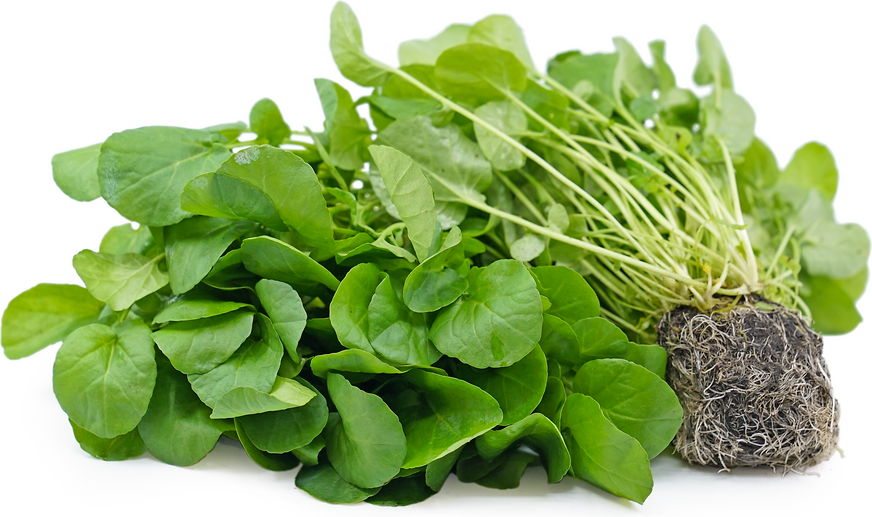


Upland Watercress
Estimated Inventory, 2 lb : 0
Description/Taste
Upland cress is small to medium in size, averaging 15-20 centimeters in diameter, and grows in rosettes of rounded, flat leaves on narrow stems. The dark green leaves are glossy and pliable with lightly serrated edges, and there is faint veining spreading across the surface. The thin stems are light green, crisp, and tender. Upland cress has a peppery, pungent flavor that is similar, but stronger, than watercress. The flavor also becomes more pungent, often acrid, and less succulent with maturity.
Seasons/Availability
Upland cress is available year-round, with peak season in the late fall through early spring.
Current Facts
Upland cress, botanically classified as Barbarea verna, is a perennial green that is a member of the Brassicaceae family. Also known as Winter cress, Dryland cress, American cress, Cassabully, Garden cress, and Creasy greens, Upland cress grows up to ten centimeters in height and can be grown in almost any soil or hydroponically. Popular in the United Kingdom and the Southern United States, Upland cress grows abundantly in the wild and is also grown commercially, often with the roots still attached to prolong storage life. Upland cress can be harvested at any time between the microgreen stage to full maturity and is used by chefs in both fresh and cooked applications.
Nutritional Value
Upland cress contains vitamins A, C, and K, vitamin B2, potassium, iron, folate, manganese, and calcium.
Applications
Upland cress is best suited for both raw and cooked applications such as steaming, boiling, or sautéing. When used fresh, the leaves can be tossed into salads, layered in sandwiches and wraps, mixed into pasta, or plated as a garnish. When cooked, the leaves are commonly mixed into soups, blended into sauces, or lightly sautéed and served alongside cooked meats. Upland cress can be used both raw and cooked similarly to greens such as kale. Upland cress pairs well with meats such as fish, poultry, ham, and smoked turkey, avocado, apples, cucumbers, onions, garlic, and Greek yogurt. The leaves will keep up to one week when wrapped in damp paper towels, placed in a sealed container, and stored in the crisper drawer of the refrigerator. If the cress was grown hydroponically and still has the roots attached, the plant will keep up to one week when stored at room temperature with the roots slightly submerged in water.
Ethnic/Cultural Info
In the southern United States, Upland cress is known as Creasy greens and grows prolifically in the wild, often classified as a weed. The leaves were originally discovered by foragers in the Appalachian Mountains as they were searching for winter greens. The leaves were then used as a source of nutrients and were used in folk medicine to help heal wounds. Today Upland cress is predominately cooked in the south rather than used topically for wounds and is stewed with ham hocks, similarly to collard greens, and is served with black-eyed peas and cornbread.
Geography/History
Upland cress is native to Southwestern Europe and has been cultivated since the 17th century in England. Today Upland cress is also naturalized in the United States and can be found at farmers markets, specialty grocers, and in the wild in Europe, Asia, and the United States.
Recipe Ideas
Recipes that include Upland Watercress. One
| Cook Almost Anything |
|
Watercress Pesto |
| Pete's Living Green Blog |
|
Upland Cress & Avocado Salad |
| Immaculate Bites |
|
Njama Njama and FuFu |




